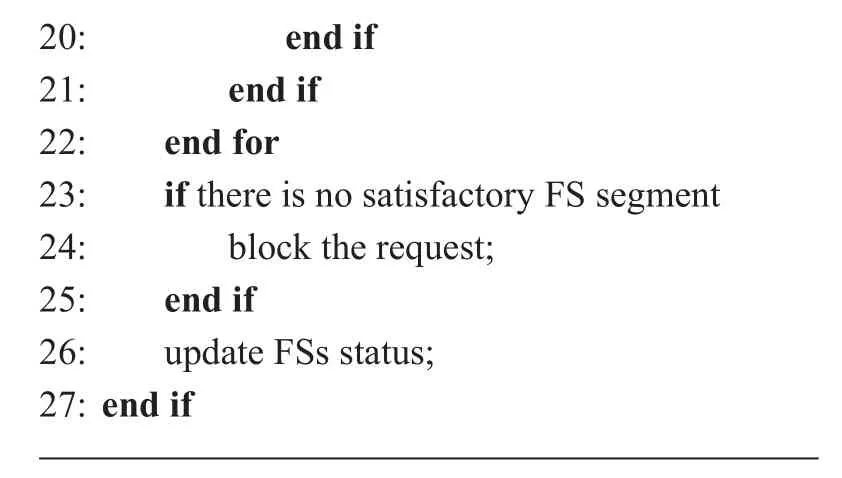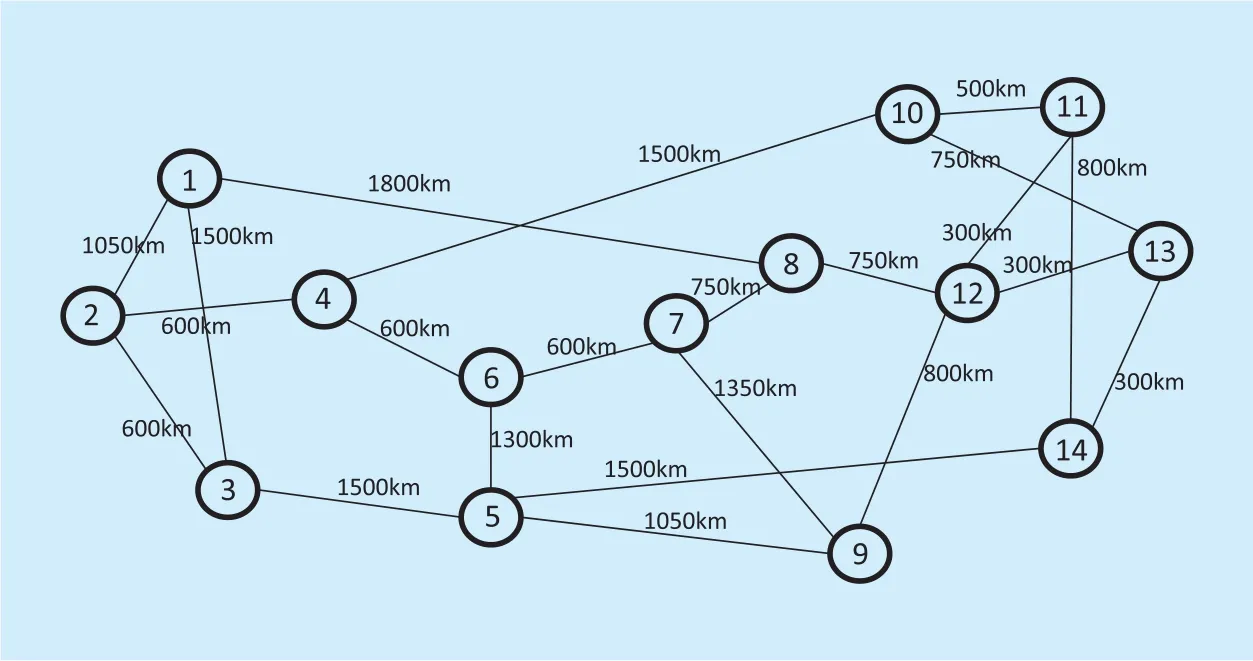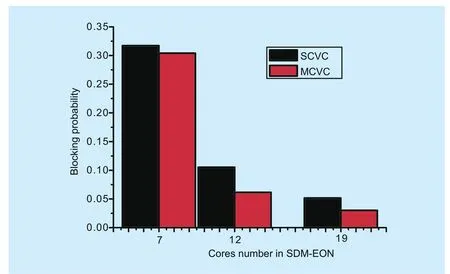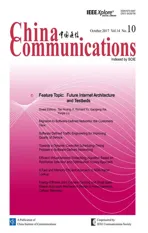Multi-Core Virtual Concatenation Scheme Considering Inter-Core Crosstalk in Spatial Division Multiplexing Enabled Elastic Optical Networks
2017-04-08YongliZhaoLiyazhouHuChunhuiWangRuijieZhuXiaosongYuJieZhang
Yongli Zhao*, Liyazhou Hu, Chunhui Wang, Ruijie Zhu, Xiaosong Yu, Jie Zhang
State Key Laboratory of Information Photonic and Optical Communication, Beijing University of Posts and Telecommunications, Beijing,100876, China.
* The corresponding author, email: yonglizhao@bupt.edu.cn
I. INTRODUCTION
As an effective approach to support highspeed optical channels beyond 100 Gbit/s,elastic optical networks (EON) were proposed to improve the spectrum efficiency of optical networks [1]. Sliceable transponder and elastic regenerator are proposed to promote the development of EON [2], and software defined networking control technology can manage the spectrum resource efficiently [3-5]. Nevertheless, the transmission capacity of single-core fiber (SCF) will reach the physical limitation soon [6]. To meet the increasing requirement for network bandwidth, spatial division multiplexing (SDM) has been investigated as an important infrastructural technique, which can improve the transmission capacity of single fiber link by using multi-core fiber (MCF) or multi-mode fiber (MMF) [7-9]. Then, spatial division multiplexing enabled elastic optical networks (SDM-EONs) will become the potential implementation form of future optical transport networks. MCF is considered as one of the most popular and efficient ways for SDM-EONs, and trench-assisted MCFs [10]are mostly preferred in SDM transmission due to the ability of avoiding crosstalk interference[6]. This paper mainly considers SDM-EONs with MCF. Three types of MCFs are considered in the paper, including 7, 12, and 19 core fibers, the structures of which are illustrated in figure 1.
In SDM-EONs, the frequent setup and torn down of lightpaths in dynamic network scenario will break the spectrum resources into non-aligned, isolated and small-sized spectrum fragments. Spectrum fragments result in low spectrum utilization and high blocking probability since these fragments could be hardly used for new incoming requests [11]. Then,how to make use of these spectrum fragments becomes an important issue for the performance improvement in SDM-EONs. How to avoid the spectrum fragmentation problem has been well studied in EONs [12-16]. In [12],the spectrum fragmentation problem is categorized as the fragmentation and misalignment subproblems, and joint routing and spectral fragmentation assignment algorithm is proposed to alleviate the spectral fragmentation in the lightpath provisioning process. Dynamic and adaptive bandwidth defragmentation (DF)in EONs with time varying traffic using connection reconfigurations was investigated in[13]. [14] studied how to take the advantage of the centralized network control and management provided by software-defined EONs for realizing OpenFlow-assisted implementation of online defragmentation (DF). However, this problem in SDM-EONs is more challenging,and there are several new features such as the mitigation of spectrum continuity constraint,which means that the signal can be exchanged from core to core freely while maintaining the same spectrum slice. Furthermore, there is an additional physical constraint introduced by inter-core crosstalk (XT). When the same spectrum slices overlap on the adjacent cores,crosstalk will occur.
Virtual concatenation mechanism [17] has been implemented in terms of multi-path provisioning in EON to improve the spectrum utilization using the non-contiguous spectral fragments based on sliceable transponders[18]. Some requests have huge bandwidth requirement, such as the data migration and data back up. The virtual concatenation can gather the spectrum segments of different cores to prevision the request. In this way, the advantage of SDM can be fully used. However, virtual concatenation is difficult to be implemented in SDM-EONs due to inter-core crosstalk and spectrum contiguity constraint across MCF.
Actually, spatial super-channel has been investigated from hardware perspective to mitigate the traditional contiguity constraint in spectrum dimension. By exploiting the highly correlated properties of different cores in single MCF, B. J. Puttnamet al. show that spatial super-channel can be achieved based on Self-Homodyne Detection (SHD) in MCF[19]. Then, spectrum resources in different cores of SDM-EONs can be fully utilized.This paper focuses on super-channel provisioning based on virtual concatenation solution in SDM-EONs. Crosstalk-aware multicore virtual concatenation scheme (MCVC) is first proposed to improve the performance of SDM-EONs in terms of blocking probability and spectrum utilization.
The rest of the paper is organized as follows. Section 2 introduces some basic knowledge of SDM-EONs including switch fabric with MCF and inter-core crosstalk. Crosstalk-aware MCVC scheme is presented in section 3. Section 4 describes the simulation results in terms of blocking probability and spectrum utilization, and section 5 concludes the paper.
A crosstalk-aware multi-core virtualization concatenation(MCVC) scheme is proposed in this paper for SDN-EONs.
II. SDM-EON
2.1 Switch fabric in SDM-EON with multi-core fiber

Fig. 1 Multi-core fiber with different number of cores
Spectrum slots in different cores are the most important resources in SDM-EONs. A spatially and spectrally resolved optical switching node is designed in figure 2. As the most important resource in frequency domain, spectrum slot is the basic bandwidth unit in optical layer. Spectrum continuity must be followed,which means that an end-to-end lightpath must use the same spectrum slots from the source node to the destination node unless wavelength converter or OEO units are deployed at the middle nodes. Meanwhile, the service can be carried by several spectrum slots within the same core. These spectrum slots must be continuous in frequency dimension, which can be considered as spectrum contiguity constraint[4]. Of course, all the spectrum slots in one core channel should guarantee the orthogonal property.

Fig. 2 Spatially and spectrally resolved optical switching fabric

Fig. 3 Core switching with spectrum continuity

Fig. 4 (a) Schematic of trench-assisted seven-core fiber; (b) Schematic of a core with index trench
Spatially and spectrally resolved optical switching fabric is shown in figure 2. Different spatial cores on a fiber link are de-multiplexed,and bandwidth-variable wavelength selective switches (WSS) consist of a reconfigurable optical add-drop multiplexer (ROADM),allowing adding, dropping and switching of different flexible channels with granularity down to the wavelength level. The transceiver resources consist of a transceiver pool, supplying the appropriate sub-transceivers according to the traffic requirement. In the switch fabric,different spectrum slots can be switched between different cores, but must follow spectrum continuity as shown in figure 3.
2.2 Inter-core crosstalk
Inter-core crosstalk [20-22] is a key physical constraint in SDM-EONs, which severely impacts the signal quality during transmission. To decrease the inter-core crosstalk and achieve dense core arrangement, a trench-assisted MCF (TA-MCF) was developed [23].Figure 4(a) shows a schematic diagram of the seven-core model used in this paper. The schematic of a core with index trench is shown in figure 4(b). To evaluate the statistical mean inter-core crosstalk of a MCF, we adopt formulation (1). Furthermore, the coupled-power theory is considered to form formulation (2),where is the mean inter-core crosstalk [5].

In formulation (1), denotes the mean increase in inter-core crosstalk per unit length. k,r, β and wthare the relevant fiber parameters,representing the coupling coefficient, bend radius, propagation constant, and core-pitch.In formulation (2), is the number of adjacent cores and represents the fiber length. We note that the inter-core crosstalk is mainly affected by the number of adjacent cores and the length of the fiber. So, when routing, spectrum and core assignment (RSCA) algorithms are conducted in SDM-EONs, crosstalk should be considered and a certain threshold of inter-core crosstalk should be set [24].
III. MCVC SCHEME
3.1 Network model
In this paper, we consider the problem of virtual concatenation in SDM-EONs, where the spectrum resource can be simplified as Frequency Slot (FS) in each MCF link. We formulate the physical network as a graph G(V, E), where V is a set of network nodes, and E is a set of MCF links. Each link L (L∈E) is composed of a core set C, and each core has a set of FSs. Matrix Alis defined to denote the occupation status of different FS on each link l as formulation (3).

As shown in formulation (3), Alis composed of c columns and f rows, which represent c cores in link l and f FSs in each core.The matrix element Oi,jis a binary value,which is used to denote the occupation status of frequency slot (FS) i in core j. For example,Oi,j=1 means FS i in core j is available, while Oi,j=0 means the corresponding FS is occupied. For a pending end-to-end connection request, we formulate it as R(s, d, b), where s and d are the source and destination nodes, and b is the required bitrate of this request. Once an end-to-end request arrives, the network operator needs to select modulation format such as Binary Phase Shift Keying (BPSK) and Quadrature Amplitude Modulation (QAM)[25] according to Signal-to-Noise Ratio (SNR)in the selected path.

Fig. 5 Super-channel provisioning with virtual concatenation
3.2 Super-channel provisioning based on virtual concatenation
In principle, high bitrate data streams are transported as groups of sub-channels in spatial super-channel occupying the same FSs in separate cores. To simplify the problem,we assume that the transceivers located at each optical node can be sliceable, so that the spatial super-channel can be constructed with different spectrums in separated cores. This paper discusses the problem of super-channel provisioning based on virtual concatenation in SDM-EONs. Traditionally, contiguity is one of the most important constraints for building super-channel in SDM-EONs. Based on spectrum contiguity constraint, several RSCA algorithms are proposed [26-28]. However,many discontinuous FSs cannot be used to carry high bitrate requests. When a new service request arrives, maybe no core has enough vacant continuous frequency slots, and this request will be blocked. To handle this kind of un-optimal condition, we propose a multi-core virtual concatenation scheme (MCVC) considering inter-core crosstalk to build super-channels on both core and spectrum dimensions based on SHD. The corresponding pilot tones are branched from a separate core to act as the local oscillator (LO) in coherent detection of the dropped data [9], and not considered in the paper. The idea of MCVC can be illustrated as figure 5, where the FS groups of {O1,6, O2,7,O2,8, O1,9, O1,10} and {O3,1, O3,2, O4,3, O3,4} are selected to construct the super-channel for S1 and S2, respectively. MCVC scheme follows spectrum continuity constraint along the route,though the spectrum may be distributed in different cores. Then, the MCVC scheme implements the super-channel by using available continuous spectrums not only in one core, but also in other cores. It is able to make full use of spectrum resources and minimize spectral fragments. It is worth noting that the differential delay between the routing cores can be addressed with additional electronic buffering in the higher layer of the destination node [29].
3.3 Crosstalk-aware MCVC

Fig. 6 SCVC and MCVC comparison
The main ideas of crosstalk-aware multi-core virtual concatenation (MCVC) and single core virtual concatenation (SCVC) schemes are described in figure 6. Figure 6(a) is a lighpath with two hops. SCVC scheme is a typical spectral super-channel, for which each request is carried by consecutive frequency slots only in single core, where contiguity is one of the most important constraints, and many discontinuous FSs cannot be used to carry high bitrates requests [30]. For example, a super-channel with only two FSs can be built in core 0 along the lightpath as shown in figure 6(b). While for MCVC scheme, a super-channel with four FSs can be built crossing two cores along the lightpath as shown in figure 6(c). When a lightpath is setting up, the crosstalk of the lightpath will be calculated using Eq. (2). If the corresponding crosstalk value is larger than the threshold, the crosstalk will affect the signal seriously and the lightpath will not be set up. Details of MCVC scheme can be found as follow.

Scheme: Crosstalk-aware MCVC

20: end if 21: end if 22: end for 23: if there is no satisfactory FS segment 24: block the request;25: end if 26: update FSs status;27: end if
Compared with MCVC scheme, SCVC scheme does not have steps 13 to 20 in the procedure. As described above, line 2 completes the KSP algorithm, the time complexity is K*V2. Line 3 checks whether there is candidate in {P}. Lines 6 to 20 allocates the modulation format and frequency slots for the connection request. Line 7 decides the modulation format and frequency slots number. Lines 8 to 19 allocate the frequency slots. Lines 9 to 12 allocates the frequency slots in the same core,while lines 13 to 18 allocates the frequency slots in different cores. They have same time complexity, i.e.Line 24 updates the frequency slots status in the entire networks, the time complexity of which isThen, the total time complexity of MCVC iswhich is polynomial.
IV. PERFORMANCE EVALUATION
We evaluate the performance of the proposed MCVC scheme through simulations on NSFNET with14 nodes and 21 links as shown in figure7, where each node is configured with sliceable transceivers, and each link is configured as MCF. The number of FSs per core is set as 300. The fiber parameters , in formulation (1) are set as, and the threshold for the crosstalk is -32dB. Under each traffic load, the simulator generates 10000 requests following Poisson model with the fixed departing rate 0.04. The source node and destination node of each request are generated randomly. In this simulation, the bitrate requests are simplified as the number of FSs. How to choose modulation format is not illustrated in this paper,which does not affect the result to a large extent. To simplify the simulation, we choose BPSK for all the requests. Taking the SCVC scheme as the benchmark scheme, we evaluate the performance of MCVC in terms of blocking probability and spectrum utilization. In the simulation with traffic load increasing, we set the number of cores of each MCF link to be 7. The number of required FSs are evenly distributed in two conditions: from 4 to 9 and from 9 to 14. To avoid the linear and nonlinear intra-core impairments, one spectrum slot is assumed as the guardband between each lightpath. Then the total required FSs are actually 5 to 10 and 10 to 15.

Fig. 7 NSFNET topology with 14 nodes

Fig. 8 Blocking probability of MCVC and SCVC

Fig. 9 Spectrum resource utilization of MCVC and SCVC

Fig. 10 Blocking probability of different cores number

Fig. 11 Spectrum resource utilization of different cores number
Figure 8 and 9 show that both blocking probability and spectrum resource utilization grow as the traffic load increasing from 100 to 1000 erlang. It is notable that the advantages of the proposed MCVC scheme are more significant in the condition with more FS requirement, especially when traffic load is beyond 500 erlang. For SCVC scheme, the more FS a request requires, the more likely it is blocked for lacking enough FSs in one single core. However, super-channels crossing different cores can be built with MCVC scheme,which can improve the spectrum utilization and reduce the blocking probability. We also compare the performance of blocking probability and spectrum utilization of these two schemes under different core numbers. Obvious differentiations between SCVC scheme and MCVC scheme in MCFs can be observed in figure 10 and figure 11, which indicate that the proposed MCVC scheme can achieve better performance among 7-core, 12-core and 19-core MCF. The traffic load is 2000 erlang. As shown in figure 10, we can note that blocking probability of both MCVC and SCVC schemes decrease with the increasing cores number in SDM-EON, because there are more spectrum resources with core number increasing. Meanwhile, MCVC scheme can get the best performance when the core number is 12, compared with SCVC scheme. Due to the same reason, the spectrum resource utilization decrease with cores number as shown in figure 11. MCVC scheme can get higher spectrum resource utilization compared with SCVC scheme, because there will be fewer requests blocked for MCVC scheme.
The figures above indicate that the blocking probability of MCVC scheme is lower than that of SCVC scheme, while the resource utilization of MCVC scheme is higher than that of SCVC scheme both in experimental MCFs and traffic load. Both advantages can be achieved due to utilizing distributed FSs to build super-channels in spatial dimension by MCVC scheme. In the traditional methods, the small spectrum fragments are not easy to be utilized to serve the requests. However, in the algorithm we proposed, these small spectrum fragments will be gathered together to serve the requests. Therefore, less fragments will result in higher resource utilization ratio and lower blocking probability eventually.
VI. CONCLUSION
In summary, crosstalk-aware multi-core virtualization concatenation (MCVC) scheme is proposed in this paper for SDN-EONs.Simulation results show that the proposed crosstalk-aware MCVC scheme can get better performance compared with SCVC scheme in terms of blocking probability and spectrum utilization all in 7-core, 12-core, 19-core MCFs.
ACKNOWLEDGEMENT
This work has been supported in part by NSFC project (61571058, 61601052).
[1] Jinno, Masahiko, et al. “Spectrum-Efficient and Scalable Elastic Optical Path Network: Architecture, Benefits, and Enabling Technologies.” IEEE Communications Magazine vol. 47, no. 11, pp.66-73, 2009.
[2] Yongli Zhao, Bowen Chen, Jie Zhang, and Xinbo Wang, “Energy Efficiency with Sliceable Multi-Flow Transponders and Elastic Regenerators in Survivable Virtual Optical Networks,” IEEE Transaction on Communications, vol. 64, no. 6,pp. 2539-2550, 2016.
[3] Yongli Zhao, Ruiying He, Haoran Chen, Jie Zhang, Yuefeng Ji, Haomian Zheng, Yi Lin, and Xinbo Wang, “Experimental performance evaluation of software defined networking (SDN)based data communication networks for large scale flexi-grid optical networks,” Optics Express, vol. 22, no. 8, pp. 9538-9547, 2014.
[4] Hui Yang, Jie Zhang, Yongli Zhao, et al. “CSO:cross stratum optimization for optical as a service.” IEEE Communications Magazine, vol. 53,no. 8, pp. 130-139, 2015.
[5] Hui Yang, Jie Zhang, Yuefeng Ji, et al. “Performance evaluation of multi-stratum resources integration based on network function virtualization in software defined elastic data center optical interconnect.” Optics Express, vol. 23, no.24, pp. 31192, 2015.
[1] Shohei Fujii, Yusuke Hirota, Hideki Tode, and Koso Murakami, “On-demand spectrum and core allocation for reducing crosstalk in multicore fibers in elastic optical networks,” Journal of Optical Communications and Networking,vol. 6, no. 12, pp. 1059-1071, 2014.
[2] George M. Saridis, Dimitris Alexandropoulos,Georgios Zervas, and Dimitra Simeonidou, “Survey and Evaluation of Space Division Multiplexing: From Technologies to Optical Networks,”IEEE Communication Surveys & Tutorials, vol.17, no. 4, pp. 2136-2156, 2015.
[3] Peter J. Winzer, “Optical Networking Beyond WDM,” IEEE Photonics Journal, vol. 4, no. 2, pp.647-651, 2012.
[4] Milorad Cvijetic, Ivan B. Djordjevic, and Neda Cvijetic, “Dynamic multidimensional optical networking based on spatial and spectral processing,” Optics Express, vol. 20, no. 8, pp. 9144-9150, 2012.
[5] Sakaguchi J, Benjamin J. Puttnam, Werner Klaus,Yoshinari Awaji, Naoya Wada, Atsushi Kanno,Tetsuya Kawanishi, Katsunori Imamura, Harumi Inaba, Kazunori Mukasa, Ryuichi Sugizaki, Tetsuya Kobayashi, Masayuki Watanabe, “305 Tb/s space division multiplexed transmission using homogeneous 19-core fiber,” Journal of Lightwave Technology, vol. 31, no. 4, pp. 554-562,2012.
[6] Weiran Shi, Zuqing Zhu, Mingyang Zhang, and et al., “On the Eあect of Bandwidth Fragmentation on Blocking Probability in Elastic Optical Networks,” IEEE Transaction on Communications, vol. 61, pp. 2970-2978, Jul. 2013.
[7] Yawei Yin, et al., “Spectral and spatial 2D fragmentation-aware routing and spectrum assignment algorithms in elastic optical networks,”Journal of Optical Communication and Networks, vol. 5, pp. A100-A106, Oct. 2013.
[8] Mingyang Zhang, Changsheng You, Huihui Jiang, and Zuqing Zhu, “Dynamic and Adaptive Bandwidth Defragmentation in Spectrum-Sliced Elastic Optical Networks with Time-Varying Traffic,” Journal of Lightwave Technology, vol.32, pp. 1014-1023, Mar. 2014.
[9] Zuqing Zhu, et al., “OpenFlow-Assisted Online Defragmentation in Single-/Multi-Domain Software-Defined Elastic Optical Networks,” Journal of Optical Communication and Networks, vol. 7,pp. A7-A15, Jan. 2015.
[10] Mingyang Zhang, Changsheng You, and Zuqing Zhu, “On the Parallelization of Spectrum Defragmentation Reconfigurations in Elastic Optical Networks,” IEEE/ACM Transaction on Networks, vol. 24, pp. 2819-2833, Oct. 2016.
[11] Ruijie Zhu, Yongli Zhao, Hui Yang, Xiaosong Yu,Jie Zhang, et.al., “Dynamic time and spectrum fragmentation-aware service provisioning in elastic optical networks with multi-path routing,” Optical Fiber Technology, vol. 32, pp. 13-22, Dec. 2016.
[12] Hui Yang, Jie Zhang, Yongli Zhao, et al. “Multiflow virtual concatenation triggered by path cascading degree in Flexi-Grid optical networks.” Optical Fiber Technology, 2013, 19(6):604–613.
[13] Zuqing Zhu, Wei Lu, Liang Zhang, and Nirwan Ansari, “Dynamic Service Provisioning in Elastic Optical Networks With Hybrid Single-/Multi-Path Routing,” IEEE Journal of Lightwave Technology, vol. 21, no. 1, pp. 15022, 2013.
[14] Nina Skorin-Kapov, Jiajia Chen, and Lena Wosinska, “A new approach to optical networks security: Attack-aware routing and wavelength assignment,” IEEE/ACM Transactions on Networks, vol. 18, pp. 750-760, Jun. 2010.
[15] Jing Zhu, Bin Zhao, Wei Lu, and Zuqing Zhu,“Attack-aware Service Provisioning to Enhance Physical-Layer Security in Multi-Domain EONs,”Journal of Lightwave Technology, vol. 34, pp.2645-2655, Jun. 2016.
[16] Liang Zhang, Nirwan Ansari, and Abdallah Khreishah, “Anycast Planning in Space Division Multiplexing Elastic Optical Networks With Multi-Core Fibers,” IEEE Communication Letters,vol. 20, pp. 1983-1986, Oct. 2016.
[17] B. J. Puttnam, J. M. D. Mendinueta, J. Sakaguchi,R. S. Luis, W. Klaus, Y. Awaji, N. Wada, A. Kanno,and T. Kawanishi, “210 Tb/s self-homodyne PDM-WDM-SDM transmission with DFB lasers in a 19-core fiber,” in Photonics Society Summer Topical Meeting Series, Waikoloa, HI, USA, p.TuC1.2. J, July 2013.
[18] Jiajing Tu, Kunimasa Saitoh, Masanori Koshiba,Katsuhiro Takenaga, and Shoichiro Matsuo,“Design and analysis of large-effective-area heterogeneous trench-assisted multi-core fiber,” Optics Express, vol. 20, no. 14, pp. 15157-15170, 2012.
[19] Ruijie Zhu, Yongli Zhao, Hui Yang, Haoran Chen,Jie Zhang, Jason P. Jue, “Crosstalk-aware RCSA for Spatial Division Multiplexing Enabled Elastic Optical Networks with Multi-core fibers”, Chinese Optics Letters, vol. 14, no. 10, 2016.
[20] L. E. Nelson, M. D. Feuer, K. Abedin, X. Zhou, T.F. Taunay, J. M. Fini, B. Zhu, R. Isaac, R. Harel, G.Cohen, and D. M. Marom, “Spatial super-channel routing in a two-span ROADM system for space division multiplexing,” Journal of Lightwave Technology, vol. 32, no. 4, pp. 783-789,2014.
[21] Fujii, Shohei, Yusuke Hirota, and Hideki Tode,“Dynamic resource allocation with virtual grid for space division multiplexed elastic optical network,” ECOC2013, London, UK, September 2013.
[22] Muhammad A, Zervas G, Forchheimer R, “Resource allocation for space-division multiplexing: optical white box versus optical black box networking,” Journal of Lightwave Technology,vol. 33, no. 23, pp. 4928-4941, 2015.
[23] Ruijie Zhu, Yongli Zhao, Jie Zhang, Hui Yang,Yuanlong Tan, Jason P Jue, and Nannan Wang,“Multi-dimensional Resource Virtualization in Spectral and Spatial Domains for Inter-Datacenter Optical Networks,” OFC2016, Anaheim, UA,USA, Mar. 2016.
[24] Wei Lu, Xiaoliang Zhou, Long Gong, Mingyang Zhang, and Zuqing Zhu, “Dynamic Multi-Path Service Provisioning under Differential Delay Constraint in Elastic Optical Networks,” IEEE Communication Letters, vol. 17, pp. 158-161,Jan. 2013.
[25] Tode, Hideki, and Yusuke Hirota, “Routing, spectrum and core assignment for space division multiplexing elastic optical networks,” Telecommunications Network Strategy and Planning Symposium (Networks), 2014 16th International. IEEE, Funchal, Madeira, Portugal, September 2014.
杂志排行
China Communications的其它文章
- FUTURE INTERNET ARCHITECTURE AND TESTBEDS
- An SNR-Adaptive Relaying Algorithm for Multi-Antenna Cooperative Networks
- Joint Spectrum Sensing Based on Variance and Correlation Analysis
- Internet Multimedia Traffic Classification from QoS Perspective Using Semi-Supervised Dictionary Learning Models
- Energy-Efficient Framework for Virtual Machine Consolidation in Cloud Data Centers
- Design and Implementation of Cloud Platform for Intelligent Logistics in the Trend of Intellectualization
